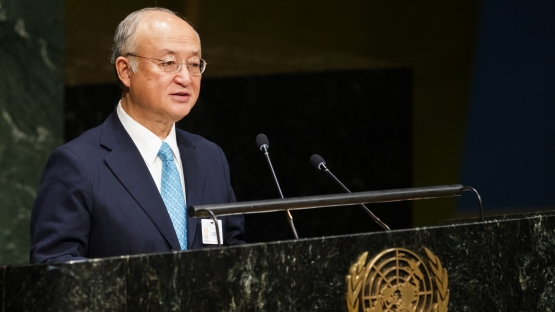IAEA Director General Yukiya Amano called for the importance of science and technology to be recognised as a central part of the global development agenda.
In his annual address to the United Nations General Assembly on 3 November 2014, he reviewed the IAEA's work over the past twelve months and outlined priorities for the future.
“The nations of the world are presently considering new sustainable development goals for the years after 2015,” the Director General said. “I believe nuclear science and technology have much to contribute to sustainable development, in areas such as human health, agriculture, water management and industrial applications, as well as in energy.”
The IAEA technical cooperation programme plays the key role in ensuring that developing countries gain access to nuclear science and technology for peaceful purposes. “The impact of our work in the daily lives of millions of people around the world is extraordinary and deserves to be better known,” Mr Amano said.
For example, the Agency works closely with partners such as the World Health Organization to save thousands of lives by helping countries to establish comprehensive cancer control programmes. “Cancer control in developing countries remains a high priority” for the IAEA, he added.
The Director General informed the General Assembly that the IAEA was helping to combat the unprecedented outbreak of Ebola Virus Disease by providing specialist diagnostic equipment to affected countries in West Africa.
Diagnosis, using a nuclear-derived technology known as RT-PCR, takes just a few hours, compared to the days it can take using other techniques. “Early diagnosis, if combined with appropriate medical care, increases patients’ chances of survival,” the IAEA Director General said. “It can also help to curtail the spread of the disease by making it possible to isolate and treat patients earlier.”
The Director General was speaking during a week-long visit to the United States during which he visited Texas A & M University, spoke at the Brookings Institution and the UN Foundation in Washington, and met senior U.S. government officials.
Texas A & M is an important partner for the IAEA in many areas of nuclear science and technology, especially nuclear power. Its Nuclear Power Institute, for example, works with the IAEA to provide nuclear education and training for engineers and scientists from countries which are thinking about introducing nuclear power.
During his visit, Director General Amano formally designated the university’s National Center for Electron Beam Research as an IAEA Collaborating Centre. The Center uses electron beam and X ray technologies for environmental, healthcare and food safety applications.
The Director General noted that the IAEA and Texas A&M were working together to increase the number of women who pursue careers in nuclear science and engineering, a subject in which he takes special interest.
In Washington, Mr Amano discussed the Agency’s activities with Secretary of State John Kerry and Energy Secretary Ernie Moniz, as well as other senior government officials.
At the Brookings Institution, the Director General focused on the Agency’s verification work, especially with regard to safeguards implementation in Iran.
He also spoke at an event co-hosted by the United Nations Association of the United States for the National Capital Area, the United Nations Foundation, and the UN Information Center. This time, the emphasis was on the Agency’s work in peaceful uses of nuclear technology.
Throughout his U.S. trip, the Director General highlighted one of the most important projects on the IAEA’s agenda at the moment, which is the modernisation of its eight nuclear applications laboratories at Seibersdorf, near Vienna.
They offer training in nuclear applications to scientists in Member States, support research in human health, food and other areas and provide analytical services to national laboratories.
“When this important project is completed in 2017, we will have modern laboratories that will meet Member State needs for decades to come,” the Director General told the General Assembly.
The full text of the IAEA Director General’s statement to the UN General Assembly can be accessed here.
The General Assembly under Resolution A/69/L.7 reaffirmed “its strong support for the indispensable role of the Agency in encouraging and assisting the development and practical application of atomic energy for peaceful uses, in technology transfer to developing countries and in nuclear safety, verification and security.”
The Resolution was adopted after Director General Amano presented the 2013 IAEA Annual Report to the Assembly.


